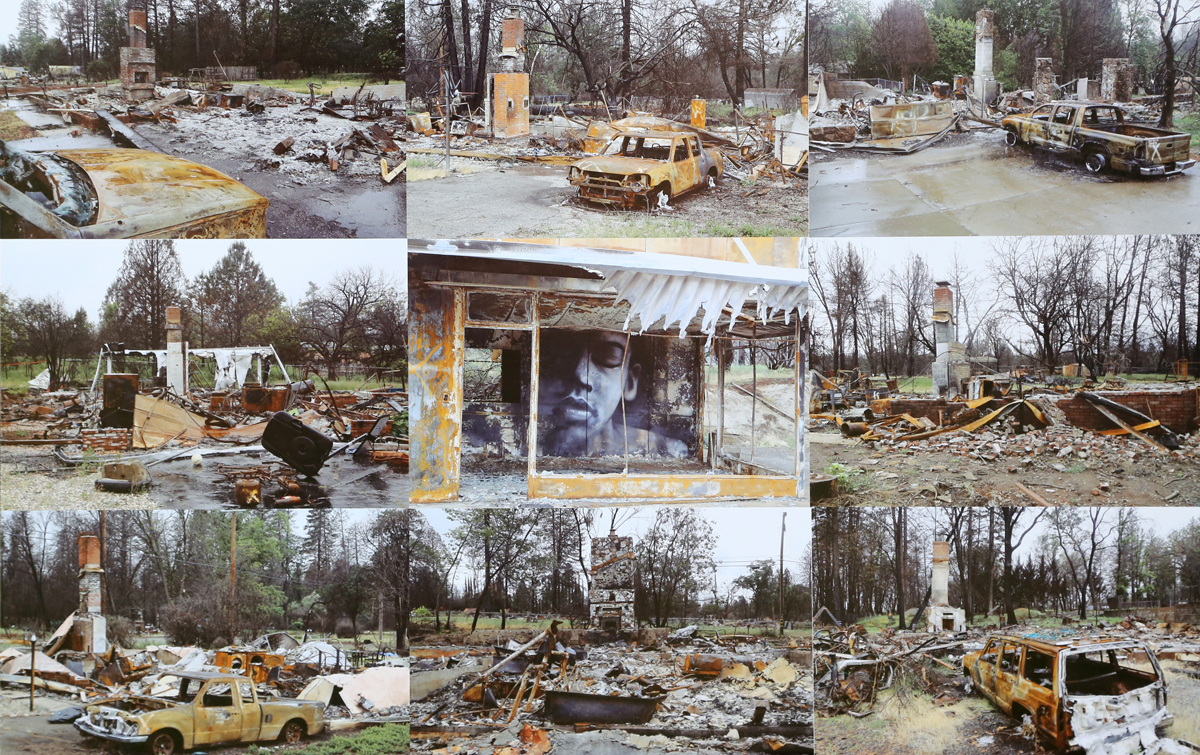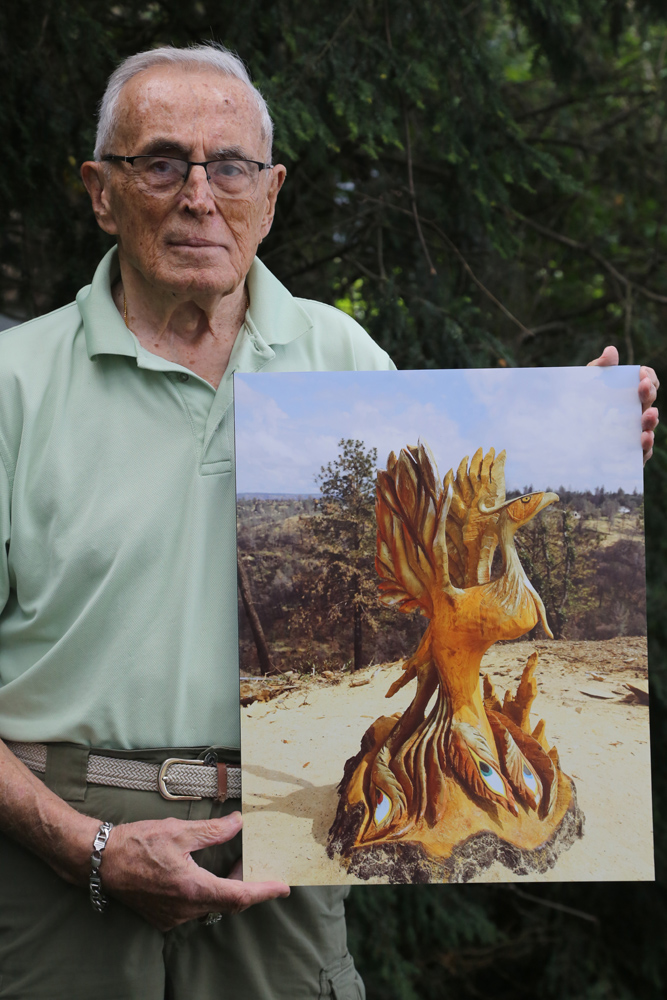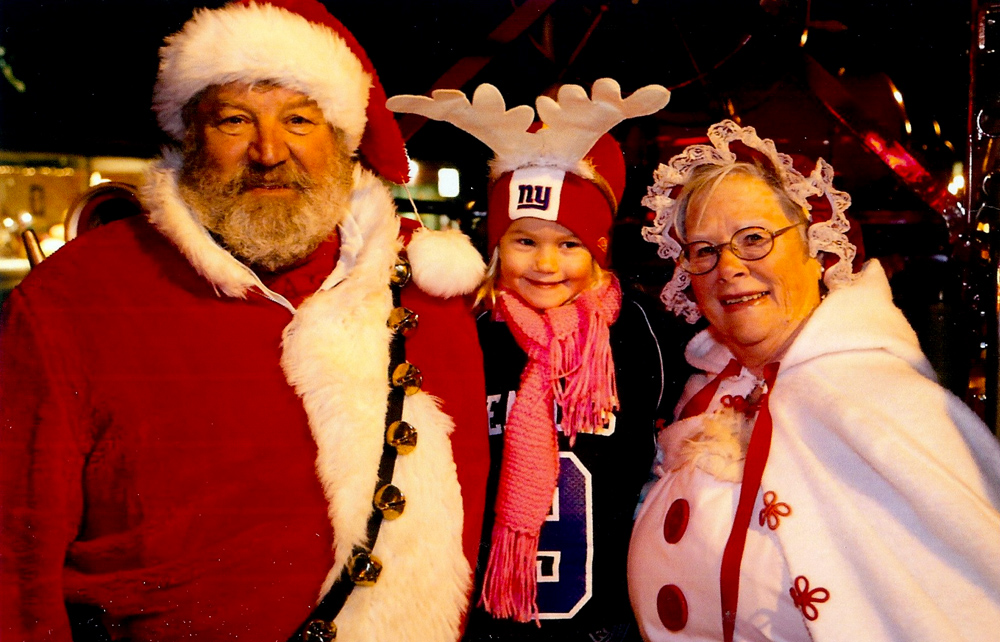Mission: Paradise – Past, Present and the Future

Former Westside News photographer Walter P. Horylev continues his interest in storytelling through images. Recent travels took him to wildfire areas in California where he captured the destruction left by sweeping flames as well as a hopeful symbol of regeneration.
by Walter P. Horylev
It began as a person on a vacation and ended up as a person on a mission. The vacation started on May 11, 2019 when I arrived in Sacramento to spend two weeks with my children, one week with my daughter, Elizabeth Seaters, and her husband, Jeff, who live in Cameron Park, a community northeast of Sacramento. The second week was to be with my son, Peter, and his wife, Sandy, who live in Paradise, a town about 100 miles to the northwest.
The first week was filled with sightseeing and relaxing, ending with a fun-filled, sociable meal that included other relatives from California, including my son Lawrence, who lives in Alameda, near San Francisco.
We left for Paradise the next day and, on arrival, took a short tour of the devastation. It was appalling. On past visits we had established certain places to patronize. Now, the Dolly-O-Doughnut Shop, where we enjoyed bear paw sweets; gone. Foster Freeze, where we had evening ice cream treats; gone. Paradise Pawn, where I sometimes picked up old coins; gone. Paradise Elementary School, which my granddaughter, Sarah, and grandson, Sean, attended; gone.
California’s worst wildfire ever, the Camp Fire, occurred in Paradise on November 8, 2018. Eighty-five people lost their lives and 90 percent of the town was destroyed, (14,000 homes), along with 70 percent of the commercial district; thousands upon thousands of trees died. The trees are what gave the retirement community ambiance, some lots had 10 to 30 trees on the property. Peter, who is co-owner of Brooklyn Bridge Bagel Works, a bakery-deli in Chico about 12 miles west of Paradise, lives on the southern outskirts of the town. He and Sandy have lived in Paradise for 40 years and they had lost their home and possessions from a fire that destroyed 50 homes in the area ten years ago. They rebuilt a beautiful house on the original site and, owing to the previous fire leaving little vegetation adjacent to their property, their new home escaped damage from the Camp Fire.
The next day, Peter and I drove around the worst remaining areas of the carnage. Now, consider, this was six months after the fire and there have been thousands of workers cleaning up disaster areas, felling trees and trying to restore power and the Internet. Still remaining were many house lots with fire residue and personal belongings on the footprint of the home, many vehicles that were totally burned out, sometimes six or more on a lot, and thousands of dead trees that needed to be cut down. Regarding the latter, there were many sites that had piles of logs strewn about; some logs were desirable wood and could be converted to lumber, others have to be shredded. (Recently, some residents have complained about the vast piles of logs still stored at various sites in the town).
I decided to take pictures of the ravaged home sites that had chimneys still upright, considering them as tombstones commemorating the site of a devastated home. My mission would be to portray some of the devastation and remark on the spirit of renewal that now exists in the area.
Included among the residue we observed were several large black and white murals in various locations. They were beautiful, sad and haunting. I photographed a few and later learned that they were created by Shane Grammar, who grew up in Paradise. The 47-year-old spray-painted 17 murals in all, placing them on the remains of buildings and destroyed vehicles. They are all gone now, having been removed as the ruins were cleared up.
It was easy to find devastation; it was hard to look at it and consider each one as a home, with occupants and vehicles in the driveway and sturdy trees surrounding the home and the lives that were lost. Other painful reminders of the tragedy were occasional smooth depressions in the road where, as Peter commented, “That’s where a car caught fire and melted the asphalt.” There were reports of people being incinerated in their cars, vainly trying to escape the Camp Fire.
We spent several hours on the road seeking appropriate scenes to photograph. (In all that time we never saw a pedestrian). After a while it became almost automatic to stop, swallow hard and record the tragedy. Paradise looked like Hell.
On a personal note, Peter and Sandy rehabbed three homes in Paradise, renting them out as a source of retirement income. They were all destroyed. Peter’s son, my grandson, Sean, and his wife Chelsea, lost their home and possessions. Chelsea’s parents lost their home. All were fortunate to escape with their lives.
Leaving the town on the Skyway, the main road out of Paradise, we noticed a sculpture being worked on out of a six foot tree trunk alongside the road. The sculpture was finished before I left California and I was lucky to be able to photograph the finished product. It’s referred to as a Phoenix, the bird of resurrection, rising out of the ashes. It was sculpted by Jesse Groeschen, from Trinidad, California. The female chainsaw artist created it considering … “The Phoenix is associated with hope.”
Now, as the town starts rebuilding, Peter recently informed me that as of late July, “8,040 properties are footprint clear, 3,420 are certified clean with no problems, 3,150 building permits have been issued, 87 homes are in the planning process and two houses recently were granted Certificate of Occupancy permits. Power was restored in six weeks; the Internet and phone lines were operational after 8-1/2 months.” One big remaining problem is removing dead trees, at the homeowners’ expense.
The mission is accomplished: The past has been recorded, the present is showing progress and the future is well in hand.
Note: Special thanks to my son Peter J. Horylev for supplying much of the data in this report.






